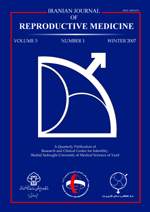
|
International Journal of Reproductive BioMedicine
Research and Clinical Center for Infertility, Shahid Sadoughi University of Medical Sciences of Yazd
ISSN: 1680-6433
EISSN: 1680-6433
Vol. 5, No. 3, 2007, pp. 99-102
|
 Bioline Code: rm07022
Bioline Code: rm07022
Full paper language: English
Document type: Research Article
Document available free of charge
|
|
|
International Journal of Reproductive BioMedicine, Vol. 5, No. 3, 2007, pp. 99-102
| en |
Frequency distribution of pregnancy occurrence in infertile women after diagnostic-surgical hysteroscopy
Nejad, Ensieh Shahrokh Tehrani; Naderi, Tayebeh; Irani, Shohreh & Nekoo, Elham Azimi
Abstract
Background: Mullerian disorders are present in 5-25% of infertile women. Myoma, polyp and endometrial adhesions are among other involved factors in infertility.
Objective: The aim of this study was to determine the frequency distribution of pregnancy occurrence in infertile women after the diagnostic-surgical hysteroscopy on selected infertile cases including those with abnormal uterine.
Materials and Methods: One hundred and fifteen women with at least 12 months infertility who had abnormal uterine cavity and patients who had at least 4 unsuccessful ART cycles with no confirmed diagnosis of uterine cavity problem, underwent diagnostic hysteroscopy and if required hysteroscopic surgery. Follow up sonography and HSG performed 2-3 months later and all subjects were followed for pregnancy occurrence for 12 months.
Results: Mean age of subjects was 32.65 ± 6.2 years and mean of infertility duration was 8.33 ± 5.25 years. Based on the sonography and HSG performed prior to the hysteroscopy, respectively 69.6% and 41.8% of the subjects had abnormality. In 65.2% of the cases, hysteroscopy showed septum, myoma, endometrial adhesion and irregularity and all of them underwent hysteroscopic operation. Among the operated cases, in 27 cases pregnancy occurred during the first 6 postoperative months and in 2 cases during the second 6 postoperative months of whom one case was EP.
Conclusion: There was no significant difference in the rate of pregnancy occurrence between those who had abnormal hysteroscopy and those who were normal (p= 0.63). This can show the variation of infertility causes and the fact that infertility is not just due to uterine problems. Therefore, the repetition of therapeutic measures and longer follow up of infertile cases are necessary.
Keywords
Infertility, Hysteroscopy, Uterine cavity problem.
|
| |
© Copyright 2007 - Iranian Journal of Reproductive Medicine
Alternative site location: http://www.ijrm.ir
|
|
